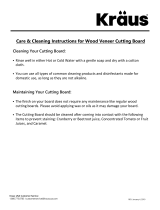
Elkay Sinks, Faucets and Accessories Care and Cleaning
Sinks
Stainless Steel
• General cleaning: use an ordinary mild detergent and soft cloth, rinse and towel dry.
• Steel soap pads should never be used; particles can adhere to a stainless steel sink surface and will eventually rust.
• Light scratches are normal for stainless steel sinks; over time they will blend into the uniform finish pattern.
• Do not use dish mats as these can trap soap and dirt making sink maintenance more time-consuming.
• We recommend the use of an Elkay bottom grid or rinsing basket to protect your sink.
• Avoid storing open containers of household cleaners and chemicals containing chloride such as bleach, acid, and drain
cleaners or toilet bowl cleaner beneath the sink. Vapor emission from the chlorides can cause corrosion and pitting to the
exposed stainless steel and other metals including faucet water supply lines.
Stainless Steel Mirror or Hammered Mirror
• General cleaning: use an ordinary mild detergent and soft cloth, rinse and towel dry.
• Never use abrasive cleaners, including steel soap pads.
Antique Copper Hammered
• General cleaning: use non-abrasive, non-detergent soap and a soft cloth, rinse and towel dry.
• Never use abrasives, metal (copper) cleaners, scouring pads, lime or rust removal, alkaline-based, ammonia-based
or acidic-based chemicals or cleaning products.
• Acidic foods such as juices and ketchup can remove the patina if left on the sink.
• Hard water spots and mineral deposits can be difficult to remove and may result in damage to the patina.
• Light scratches are normal for copper sinks; over time they will blend into the uniform finish pattern.
• Copper has a living finish and its surface tarnishes naturally. You can expect tarnish, scratches, and dents
to appear in your sink over time.
CuVerro® Anti-microbial Copper
• Clean the surface to regular hospital protocols (i.e. appropriate disinfectants, frequency, etc.); be sure to rub
in the direction of the satin finish grain lines; rinse and towel dry.
• Use a cleaner that will not leave a wax film or coating on the surface, so that cleaning will not interfere with the
antimicrobial action of the surface.
• Never use abrasives, metal (copper) cleaners, scouring pads, lime or rust removal, alkaline-based, ammonia-based
or acidic-based chemicals or cleaning products.
• Light scratches are normal for copper sinks; over time they will blend into the uniform finish pattern.
Cast Brass
• General cleaning: use a non-abrasive, non-detergent soap with a soft cloth, rinse and towel dry.
• Never use abrasives, metal cleaners, scouring pads, lime or rust removal, alkaline-based, ammonia-based or
acidic-based chemicals or cleaning products.
• Brass has a living finish and its surface tarnishes naturally. You can expect tarnish, scratches, and dents to appear
in your sink over time.
• Surface waxing is recommended. Each sink provides a factory applied layer of wax. However, after time and use,
this wax layer will need to be rejuvenated. Johnson’s or Trewax Sealer Finish for floors is recommended. Do not use
any waxes that contain polishing agents.
e-granite™ or Quartz
• Most dirt and stains: Wipe with a damp cotton cloth/sponge and soapy water. Towel dry with a cotton cloth.
It is recommended that you clean your sink prior to first use.
• Stubborn stains and water marks: Wipe with a Mr. Clean® Magic Eraser® and either
water or a 50/50 white vinegar and water solution. Towel dry with a cotton cloth.
• Difficult stains: Use a 3M Scotch-Brite™ Heavy Duty Scour Pad with either water, 50/50 white vinegar/water solution
or non-abrasive cleaner. Start cleaning in a a circular motion with constant pressure over the area of the stain, rinse
thoroughly with water and dry with a cotton cloth. Let dry 5-10 minutes. If stain persists, repeat.



